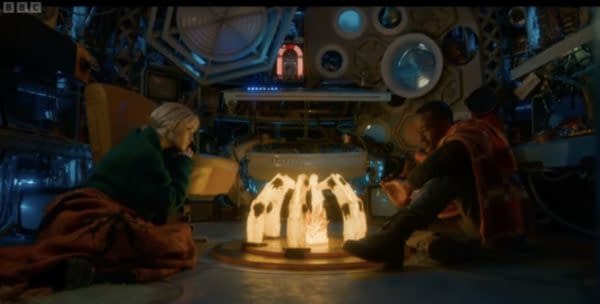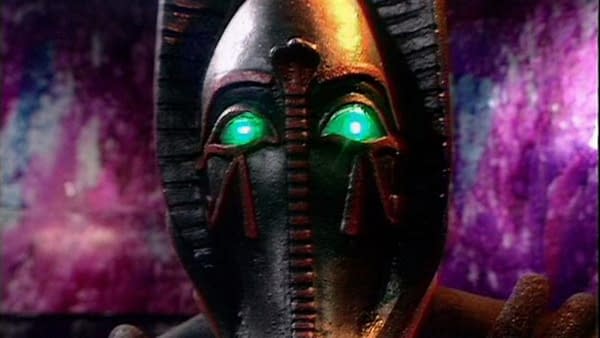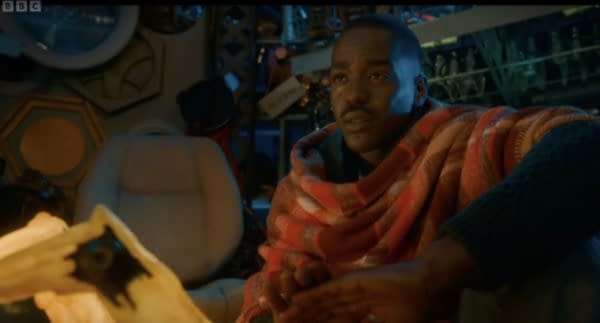Posted in: BBC, Disney+, Review, TV | Tagged: bbc, doctor who, Millie Gibson, Ncuti Gatwa, russell t davies, Tales of the TARDIS
Doctor Who: "Pyramids of Mars" Retell Gets Fresh Coat of Pain (REVIEW)
Doctor Who series Tales of the TARDIS retells "Pyramids of Mars," with Ncuti Gatwa & Millie Gibson offering short, emotional framing scenes.
The Doctor Who spinoff Tales of the TARDIS aired and streamed in the UK on BBC Four and BBC iPlayer before the premiere of "Empire of Death" to catch fans and new viewers up on the classic story "Pyramids of Mars" in a new, tighter edit and given a fresh coat of paint with updated FX. It begins and ends with a framing scene written by showrunner Russell T. Davies where the Fifteenth Doctor (Ncuti Gatwa) and Ruby (Millie Gibson) sitting in the Memory TARDIS like two campers at a fire with no explanation for how they got here or asking how they got here. Are they trapped? Are they hiding? No explanation is offered. The Doctor tells her about the last time they (Tom Baker) fought Sutekh (Gabriel Woolf) with Sarah Jane Smith (Elisabeth Sladen).

Viewed in the context of 2024, "Pyramids of Mars" starts with a more trenchant commentary on colonialism when the Fifteenth Doctor introduces the story by telling Ruby it kicked off in early 20th Century Egypt when archeologist Professor Scarman was raiding the tombs of the pharaohs. Back then, including in adventure fiction, archeological digs and tomb-raiding were seen as normal, the right of an Englishman out to make a name for himself with no thought that they were robbing another nation's treasures. The story itself could be seen as a lesson, even in 1975, in the perils of interfering with another culture.

The Most "Doctor Who" of Doctor Who Stories
There's a reason "Pyramids of Mars" is considered a classic Doctor Who story fan favourite. It's one of the quintessential stories that sums up the whole series, showing you everything the show and the characters are about. Tom Baker, as the Fourth Doctor, practically declared his mission statement in this story, though this was his second season. This was when Baker was still fresh in the role before he became too knowing and practically winked at the camera later in his run. He plays all the different sides of a Doctor here: brooding, mercurial, whimsical, drily funny, whimsical before it went over the top. Elisabeth Sladen shows why Sarah Jane Smith is one of the greatest and most archetypal companions: smart, defiant, funny, and constantly poking at the Doctor's pomposity. The Doctor is often quite mean to Susan, snapping at her constantly while she snipes back at him like bickering besties.

"Pyramids of Mars" was written by Robert Holmes, possibly the most prolific and talented of classic Doctor Who, under the pseudonym "Stephen Harris" after he extensively revised the script by Lewis Griefer, whom some consider the creator of Sutekh. There's a fun, almost camp, old-school Hammer Horror vibe to the story, and the acting style of the supporting cast is also very old-school and lots of fun. Nobody acts in that style anymore, not even in period dramas and movies set in that period. This was part of the popular "gothic horror" period of Doctor Who under much-praised producer and showrunner Philip Hinchcliffe, who encouraged stories lifted from classic Horror. "Pyramids of Mars" is a Science Fiction take on the Mummy horror movies like Curse of the Mummy's Tomb. Only Elisabeth Sladen, as Sarah Jane, speaks and acts like a contemporary person. The story was directed by Paddy Russell, one of the very rare female directors on Doctor Who and the BBC in the 1970s.
A Fresh Coat of "Pain-t"
The re-edited "Pyramids of Mars" consists of trims that tighten the pacing of the story as it cuts the four parts from 98 minutes down to around 73 minutes minus the framing scenes with Gatwa and Gibson. Extraneous lines are removed, pauses are shortened to up the pace so that younger viewers are able to get through it. The updated FX is a fresh coat of paint, like a bit of digital blurring for contact with a forcefield, and the time corridor FX has been replaced from the old video chromakey colors to the swirling vortex familiar with the modern series.

So Tales of the TARDIS ends with the Fifteenth Doctor lamenting to Ruby that Sutekh was the size of a man then and has evolved into a titan – and he has no idea how to stop him. This places this episode square sometime during "Empire of Death," as Russell T. Davies intended. Gatwa still injects his handful of lines with sadness and pathos, still missing Sarah Jane and despairing that he may be defeated. Did Davies create Tales of the TARDIS partly so he could reintroduce "Pyramids of Mars" to new viewers? It feels that way. Who are we to object? It's not just a piece of Doctor Who canon but also a time capsule of how television was made in the 1970s.
Tales of the TARDIS is only on BBC iPlayer in the UK. Doctor Who is streaming worldwide outside the UK on Disney+.















